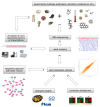Bivalve omics: state of the art and potential applications for the biomonitoring of harmful marine compounds
- PMID: 24189277
- PMCID: PMC3853733
- DOI: 10.3390/md11114370
Bivalve omics: state of the art and potential applications for the biomonitoring of harmful marine compounds
Abstract
The extraordinary progress experienced by sequencing technologies and bioinformatics has made the development of omic studies virtually ubiquitous in all fields of life sciences nowadays. However, scientific attention has been quite unevenly distributed throughout the different branches of the tree of life, leaving molluscs, one of the most diverse animal groups, relatively unexplored and without representation within the narrow collection of well established model organisms. Within this Phylum, bivalve molluscs play a fundamental role in the functioning of the marine ecosystem, constitute very valuable commercial resources in aquaculture, and have been widely used as sentinel organisms in the biomonitoring of marine pollution. Yet, it has only been very recently that this complex group of organisms became a preferential subject for omic studies, posing new challenges for their integrative characterization. The present contribution aims to give a detailed insight into the state of the art of the omic studies and functional information analysis of bivalve molluscs, providing a timely perspective on the available data resources and on the current and prospective applications for the biomonitoring of harmful marine compounds.
Figures



Similar articles
-
p53 Superfamily proteins in marine bivalve cancer and stress biology.Adv Mar Biol. 2011;59:1-36. doi: 10.1016/B978-0-12-385536-7.00001-7. Adv Mar Biol. 2011. PMID: 21724017 Review.
-
Chromatin specialization in bivalve molluscs: a leap forward for the evaluation of Okadaic Acid genotoxicity in the marine environment.Comp Biochem Physiol C Toxicol Pharmacol. 2012 Mar;155(2):175-81. doi: 10.1016/j.cbpc.2011.09.003. Epub 2011 Sep 16. Comp Biochem Physiol C Toxicol Pharmacol. 2012. PMID: 21946397 Review.
-
Biomonitoring of trace metal pollution using the bivalve molluscs, Villorita cyprinoides, from the Cochin backwaters.Environ Monit Assess. 2013 Dec;185(12):10317-31. doi: 10.1007/s10661-013-3334-9. Epub 2013 Jul 7. Environ Monit Assess. 2013. PMID: 23832233
-
Ancestral Physical Stress and Later Immune Gene Family Expansions Shaped Bivalve Mollusc Evolution.Genome Biol Evol. 2021 Aug 3;13(8):evab177. doi: 10.1093/gbe/evab177. Genome Biol Evol. 2021. PMID: 34343278 Free PMC article.
-
The use of -omic tools in the study of disease processes in marine bivalve mollusks.J Invertebr Pathol. 2015 Oct;131:137-54. doi: 10.1016/j.jip.2015.05.007. Epub 2015 May 25. J Invertebr Pathol. 2015. PMID: 26021714 Review.
Cited by
-
Meta-analysis of studies using suppression subtractive hybridization and microarrays to investigate the effects of environmental stress on gene transcription in oysters.PLoS One. 2015 Mar 13;10(3):e0118839. doi: 10.1371/journal.pone.0118839. eCollection 2015. PLoS One. 2015. PMID: 25768438 Free PMC article.
-
Molecular Diversity of Mytilin-Like Defense Peptides in Mytilidae (Mollusca, Bivalvia).Antibiotics (Basel). 2020 Jan 19;9(1):37. doi: 10.3390/antibiotics9010037. Antibiotics (Basel). 2020. PMID: 31963793 Free PMC article.
-
Application of Biomarker Tools Using Bivalve Models Toward the Development of Adverse Outcome Pathways for Contaminants of Emerging Concern.Environ Toxicol Chem. 2020 Aug;39(8):1472-1484. doi: 10.1002/etc.4757. Epub 2020 Jun 23. Environ Toxicol Chem. 2020. PMID: 32452040 Free PMC article.
-
Convergence of virulence and resistance in international clones of WHO critical priority enterobacterales isolated from Marine Bivalves.Sci Rep. 2022 Apr 5;12(1):5707. doi: 10.1038/s41598-022-09598-8. Sci Rep. 2022. PMID: 35383231 Free PMC article.
-
MytiLec, a Mussel R-Type Lectin, Interacts with Surface Glycan Gb3 on Burkitt's Lymphoma Cells to Trigger Apoptosis through Multiple Pathways.Mar Drugs. 2015 Dec 14;13(12):7377-89. doi: 10.3390/md13127071. Mar Drugs. 2015. PMID: 26694420 Free PMC article.
References
-
- Ruppert E.E., Fox R.S., Barnes R.D. Invertebrate Zoology: A Functional Evolutionary Approach. 7th ed. Cengage Learning; Stamford, CT, USA: 2004.
-
- Gosling E.M. Bivalve Molluscs: Biology, Ecology and Culture. Oxford Fishing New Books, Blackwell Science; Oxford, UK: 2003.
-
- Newell R. Ecosystem influences of natural and cultivated populations of suspension-feeding bivalve molluscs: A review. J. Shellfish Res. 2004;23:51–61.
-
- Suarez-Ulloa V., Fernandez-Tajes J., Aguiar-Pulido V., Rivera-Casas C., Gonzalez-Romero R., Ausio J., Mendez J., Dorado J., Eirin-Lopez J.M. The CHROMEVALOA database: A resource for the evaluation of okadaic acid contamination in the marine environment based on the chromatin-associated transcriptome of the mussel Mytilus galloprovincialis. Mar. Drugs. 2013;11:830–841. doi: 10.3390/md11030830. - DOI - PMC - PubMed
Publication types
MeSH terms
LinkOut - more resources
Full Text Sources
Other Literature Sources

